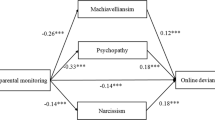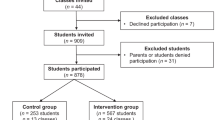Abstract
The phenomenon of hating is becoming common in adolescence, but it has been rarely investigated. The study aimed to examine the relationships between hating behaviors, maladaptive personality traits, and cognitive distortions, and to explore whether cognitive distortions might intervene in the relationship between personality traits and hating. Method: Participants (200 boys and 202 girls) completed the Hating Adolescents Test (HAT), the Personality Inventory for DSM-5-Brief Form-Children (PID-5), and the How I Think Questionnaire (HITQ). Results: Preliminary results showed significant gender differences in the study’s variables: boys reported higher scores than girls on hating and on cognitive distortion minimizing, whereas no significant differences emerged on maladaptive personality traits. The mediation model showed that the cognitive distortion blaming others mediated the relationship between psychoticism and hating. Conclusions: Data suggested a mediating role of cognitive distortion blaming others in the relationship between psychoticism trait and hating behaviors.


Similar content being viewed by others
References
Barriga, A. Q., Gibbs, J. C., Potter, G. B., & Liau, A. K. (2001). Test manual for the how I think questionnaire. Champaign: Research Press.
Björkqvist, K. (2018). Gender differences in aggression. Current Opinion in Psychology, 19, 39–42.
Blaya, C. (2018). Cyberhate: A review and content analysis of intervention strategies. Aggression and Violent Behavior. https://doi.org/10.1016/j.avb.2018.05.006.
Blumenthal, S., Gudjonsson, G., & Burns, J. (1999). Cognitive distortions and blame attribution in sex offenders against adults and children. Child Abuse & Neglect, 23, 129–143.
Chetty, N., & Alathur, S. (2018). Hate speech review in the context of online social networks. Aggression and Violent Behavior, 40, 108–118.
Craig, K. (2002). Examining hate-motivated aggression: A review of the social psychological literature on hate crimes as a distinct form of aggression. Aggression and Violent Behavior, 7, 85–101.
D’Urso, G., Petruccelli, I., Costantino, V., Zappulla, C., & Pace, U. (2018a). The role of moral disengagement and cognitive distortions toward children among sex offenders. Psychiatry, Psychology and Law. https://doi.org/10.1080/13218719.2018.1506718.
D’Urso, G., Petruccelli, I., Grilli, S., & Pace, U. (2018b). Risk factors related to cognitive distortions toward women and moral disengagement: A study on sex offenders. Sexuality and Culture, 22, 1310–1320.
D’Urso, G., Petruccelli, I., & Pace, U. (2018c). Drug use as risk factor of moral disengagement: A study on drug traffickers and offenders against other persons. Psychiatry, Psychology and Law, 25, 417–424.
Di Maggio, R., Zappulla, C., & Pace, U. (2016). The relationship between emotion regulation, emotion knowledge and adjustment in preschoolers: A mediation model. Journal of Child and Family Studies, 25, 2626–2635.
Fossati, A., Somma, A., Borroni, S., Markon, K. E., & Krueger, R. F. (2015). The personality inventory for DSM-5 brief form: Evidence for reliability and construct validity in a sample of community-dwelling Italian adolescents. Assessment, 24, 615–631.
Gamblin, B. W., Kehn, A., Vanderzanden, K., Ruthig, J. C., Jones, K. M., & Long, B. L. (2018). A comparison of juror decision making in race-based and sexual orientation-based hate crime cases. Journal of Interpersonal Violence. https://doi.org/10.1177/0886260518774305.
Gannon, T. A. (2009). Current cognitive distortion theory and research: An internalist approach to cognition. Journal of Sexual Aggression, 15, 225–246.
Grieve, R., & Panebianco, L. (2013). Assessing the role of aggression, empathy, and self-serving cognitive distortions in trait emotional manipulation. Australian Journal of Psychology, 65, 79–88.
Guzzo, G., Lo Cascio, V., & Pace, U. (2013). The role of individual and relational characteristics on alcohol consumption among Italian adolescents: A discriminant function analysis. Child Indicators Research, 6, 605–618.
Harkness, A. R., Reynolds, S. M., & Lilienfeld, S. O. (2014). A review of systems for psychology and psychiatry: Adaptive systems, personality psychopathology five (PSY-5), and the DSM-5. Journal of Personality Assessment, 96, 121–139.
Hayes, A. F. (2013). Introduction to mediation, moderation, and conditional process analysis: A regression-based approach. New York: The Guilford Press.
Hayes, A. F. (2015). An index and test of linear moderated mediation. Multivariate Behavioral Research, 50, 1–22.
Kauppinen, A. (2014). Hate and punishment. Journal of Interpersonal Violence, 30, 1719–1737.
Krueger, R. F., Derringer, J., Markon, K. E., Watson, D., & Skodol, A. E. (2012). Initial construction of a maladaptive personality trait model and inventory for DSM-5. Psychological Medicine, 42, 1879–1890.
Markey, P. M., & Scherer, K. (2009). An examination of psychoticism and motion capture controls as moderators of the effects of violent video games. Computers in Human Behavior, 25, 407–411.
Noser, A. E., Zeigler-Hill, V., Vrabel, J. K., Besser, A., Ewing, T. D., & Southard, A. C. (2015). Dark and immoral: The links between pathological personality features and moral values. Personality and Individual Differences, 75, 30–35.
Pace, U., Schimmenti, A., Zappulla, C., & Di Maggio, R. (2013). Psychological variables characterizing different types of adolescent gamblers: A discriminant function analysis. Clinical Neuropsychiatry, 10, 253–259.
Pace, U., D’Urso, G., & Zappulla, C. (2018a). Negative eating attitudes and behaviors among adolescents: The role of parental control and perceived peer support. Appetite, 121, 77–82.
Pace, U., Passanisi, A., & D’Urso, G. (2018b). Emotional and cognitive correlates of hating among adolescents: An exploratory study. Journal of Adolescence, 68, 159–164.
Pace, U., Zappulla, C., & D’Urso, G. (in press). Hating Adolescents’ Test (HAT): A preliminary development of a measure to assess hating among adolescents. Psychiatry Psychology and Law.
Passanisi, A., & Pace, U. (2017). The unique and common contributions of impulsivity and decision-making strategies among young adult Italian regular gamblers. Personality and Individual Differences, 105, 24–29.
Petruccelli, I., Simonelli, C., Barbaranelli, C., Grilli, S., Tripodi, M. F., & D'Urso, G. (2017). Moral disengagement strategies in sex offenders. Psychiatry, Psychology and Law, 24, 470–480.
Preacher, K. J., & Hayes, A. F. (2008). Asymptotic and resampling strategies for assessing and comparing indirect effects in multiple mediator models. Behavior Research Methods, 40, 879–891.
Preacher, K., Rucker, D. D., & Hayes, A. F. (2007). Addressing moderated mediation hypotheses: Theory, methods, and prescriptions. Multivariate Behavioral Research, 42, 185–227.
Scott, B. G., Pina, A. A., & Parker, J. H. (2017). Reluctance to express emotion explains relation between cognitive distortions and social competence in anxious children. British Journal of Developmental Psychology. https://doi.org/10.1111/bjdp.12227.
Villani, D., Gatti, E., Triberti, S., Confalonieri, E., & Riva, G. (2016). Exploration of virtual body-representation in adolescence: The role of age and sex in avatar customization. SpringerPlus, 5(1), 740.
Walker, J. S., & Gudjonsson, G. H. (2006). The Maudsley violence questionnaire: Relationship to personality and self-reported offending. Personality and Individual Differences, 40, 795–806.
Author information
Authors and Affiliations
Corresponding author
Ethics declarations
Conflict of Interest
Ugo Pace declares that he has not any conflict of interest and that the study was not funded. Giulio D'Urso declares that he has not any conflict of interest and that the study was not funded. Carla Zappulla declares that she has not any conflict of interest and that the study was not funded.
Ethical Approval
All procedures performed in studies involving human participants were in accordance with the ethical standards of the institutional and/or national research committee and with the 1964 Helsinki declaration and its later amendments or comparable ethical standards.
This Research did not receive any funds.
Informed Consent
Informed consent was obtained from all individual participants included in the study.
Additional information
Publisher’s Note
Springer Nature remains neutral with regard to jurisdictional claims in published maps and institutional affiliations.
Rights and permissions
About this article
Cite this article
Pace, U., D’Urso, G. & Zappulla, C. Hating among adolescents: Common contributions of cognitive distortions and maladaptive personality traits. Curr Psychol 40, 3326–3331 (2021). https://doi.org/10.1007/s12144-019-00278-x
Published:
Issue Date:
DOI: https://doi.org/10.1007/s12144-019-00278-x




